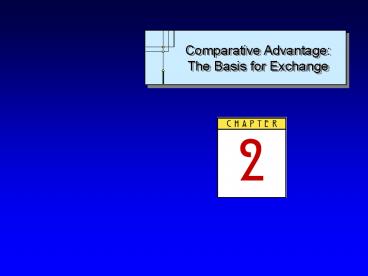Comparative Advantage: - PowerPoint PPT Presentation
1 / 32
Title:
Comparative Advantage:
Description:
Produces only two goods - coffee and nuts. Has only one worker (Susan) who works 6 hrs/day ... Tom's Output = 2 hrs picking nuts = 8 lbs 4 hrs picking coffee = 8 lbs ... – PowerPoint PPT presentation
Number of Views:1064
Avg rating:3.0/5.0
Title: Comparative Advantage:
1
Comparative Advantage The Basis for Exchange
2
Exchange and Opportunity Cost
- Absolute Advantage
- One person has an absolute advantage over another
if he takes fewer hours to perform a task than
the other person
3
Exchange and Opportunity Cost
- Comparative Advantage
- One person has a comparative advantage over
another if his opportunity cost of performing a
task is lower than the other persons opportunity
cost
4
Exchange and Opportunity Cost
- The Principle of Comparative Advantage
5
Opportunity Costsfor Paula and Beth
- The Principle of Comparative Advantage
6
Exchange and Opportunity Cost
- The Principle of Comparative Advantage
- Should Paula update her own web page?
- How many web pages and bicycle repairs can Paula
and Beth produce a day if they both work eight
hour days?
7
Exchange and Opportunity Cost
- The Principle of Comparative Advantage
If they split their time evenly and produce 16
web pages
8
Exchange and Opportunity Cost
- The Principle of Comparative Advantage
If they specialized in their comparative advantage
9
Exchange and Opportunity Cost
- The Principle of Comparative Advantage
- Everyone does best when each person (or each
country) concentrates on the activities for which
his or her opportunity cost is lowest
10
Comparative Advantage and Production Possibilities
- The Production Possibilities Curve
- A graph that describes the maximum amount of one
good that can be produced for every possible
level of production of the other good.
11
Comparative Advantage and Production Possibilities
- The Production Possibilities Curve
- Assume
- A small economy that
- Produces only two goods - coffee and nuts
- Has only one worker (Susan) who works 6 hrs/day
- 2 lbs nuts or 4 lbs coffee per hour
12
Susans Production Possibilities
Coffee (lb/day)
Nuts (lb/day)
0
13
Susans Production Possibilities
The scarcity principle Having more of one good
generally means having less of another good.
14
Comparative Advantage and Production Possibilities
- The Production Possibilities Curve
- Attainable Point
- Any combination of goods that can be produced
using currently available resources - Unattainable Point
- Any combination that cannot be produced using
currently available resources
15
Comparative Advantage and Production Possibilities
- The Production Possibilities Curve
- Efficient Point
- Any combination of goods for which currently
available resources do not allow an increase in
the production of one good without a reduction in
the production of the other
16
Comparative Advantage and Production Possibilities
- The Production Possibilities Curve
- Inefficient Point
- Any combination of goods for which currently
available resources enable an increase in the
production of one good without a reduction in the
production of the other
17
Attainable and Efficient Points on Susans
Production Possibilities
Coffee (lb/day)
A
24
Combination F Unattainable
B
16
Combination E Inefficient
C
8
Combinations A, B, C, and D Efficient
D
Nuts (lb/day)
0
4
8
12
18
Toms ProductionPossibilities Curve
Toms Production Possibilities Curve for a 6 hour
day
Coffee (lb/day)
Nuts (lb/day)
0
How Individual Productivity Affects the Slope and
Position of the Production Possibilities Curve
19
Individual Production Possibilities Curves
Compared
Coffee (lb/day)
Nuts (lb/day)
0
20
Production Without Specialization
21
Production With Specialization
22
Comparative Advantageand Production Possibilities
- The gains from specialization grow larger as the
difference in opportunity cost increases - For Example
- Susan 5 lb coffee/hr 1 lb nuts/hr
- Tom 1 lb nuts/hr 5 lb coffee/hr
23
Comparative Advantage and Production
Possibilities
- The gains from specialization grow larger as the
difference in opportunity cost increases - Without Specialization
- Tom 5 hrs coffee 5 lb 1 hr nuts 5 lb
- Susan 1 hr coffee 5 lb 5 hrs nuts 5 lb
- Total 10 lb
10 lb
24
Comparative Advantageand Production Possibilities
- The gains from specialization grow larger as the
difference in opportunity cost increases - With Specialization
- Tom 30 lb coffee 0 lb nuts
- Susan 0 lb coffee 30 lb nuts
- Total 30 lb 30 lb
25
Production PossibilitiesCurve For a Large Economy
Assume An economy that produces only two
goods, coffee and nuts
Coffee (1000s of lb/day)
Nuts (1000s of lb/day)
26
Comparative Advantage and Production Possibilities
- The Principle of Increasing Opportunity Cost
(The Low-Hanging-Fruit Principle) - In expanding the production of any good, first
employ those resources with the lowest
opportunity costs, and only afterward turn to
resources with higher opportunity costs
27
Economic Growth An Outward Shift in the
Economys PPC
Coffee (1000s of lb/day)
Nuts (1000s of lb/day)
28
Factors That Shift The Economys Production
Possibilities Curve
- Increasing Productive Resources
- Investment in new factories and equipment
- Population growth
- Improvements in knowledge and technology
- Increasing education
- Gains from specialization
29
Factors That Shift The Economys Production
Possibilities Curve
- Why Have Countries Been So Slow to Specialize?
- Low population density
- Isolation
- Factors that may limit specialization in other
countries - Laws
- Customs
30
Factors That Shift The Economys Production
Possibilities Curve
- Can we have too much specialization?
- What do you think?
- What are the costs of specialization?
31
Comparative Advantage and International Trade
- Economic Naturalist
- If trade between nations is so beneficial, why
are free-trade agreements so controversial?
32
End of Chapter

